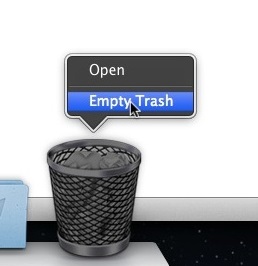
- #Force empty trash mac files in use mac os x#
- #Force empty trash mac files in use install#
- #Force empty trash mac files in use free#
Perform the following steps in the order specified:
#Force empty trash mac files in use mac os x#
This technique uses a hidden feature of Mac OS X to force the Trash to empty. Force the Trash to empty using the Option key Note: Be sure to employ a version of the utility that is compatible with the version of Mac OS X you are using. Using one of these utilities is often the fastest way to Trash recalcitrant files.
#Force empty trash mac files in use install#
You may want to download and install the freeware utility Trash It! or the shareware utility Cocktail. Techniques for solving Trash problems Trash utilities for eradicating troublesome files In reality, Trash is displaying a list that is the union of the contents of all of the individual Trash folders associated with your account, on all writable volumes.
When you open Trash to view its contents, it appears that all of the objects you have trashed are in a single Trash folder. Trashes at the root (top) level of the volume, which in turn contains an invisible Trash folder for each user. If you have secondary hard drives or other writable volumes connected to your Mac, each contains an invisible Trash folder named. Because each user's Trash is private, viewing the contents of the Trash shows only objects that you have placed into the Trash. The UNIX® directory path for this folder when logged in to your account is ~/.Trash. Each user has their own private, hidden, and invisible Trash folder, located in their Home folder. Mac OS X introduced a new architecture for Trash: Files dragged to the Trash "will be deleted immediately" alert. Incomplete Internet downloads under Mac OS X 10.2. Insufficient privileges needed to Trash an object. Resolving common Trash problems: solutions for the following common Trash problems:. Force the Trash to empty using the Option key. Trash utilities for eradicating troublesome files. Techniques for solving Trash problems: common approaches to a variety of Trash problems, including:. About the Trash in Mac OS X: a brief overview of the Trash architecture. This FAQ, derived from our book Troubleshooting Mac OS X, covers the following Trash-related topics: Select Delete Immediately from the dialog box that appears, and the user account will gone, along with the stubborn file.A variety of issues can result in making it difficult or impossible to either move files to, or empty, the Trash in Mac® OS X. Return to the Accounts pane in the System Preferences and delete the temporary account by selecting it from the list and hitting the delete key. Then log back out, and go back to your normal user account. From here, move the file into this users trash. Log out of your account and log into the newly created one. Next, move the troublesome file from your trash to the Shared folder, located in the Users folder. It doesn't matter what details you give it, just remember the password. Start by going to the Accounts preference pane in the System Preferences and creating a new user account. This method is a little time consuming, but it is great if you don't want to use the Terminal. Method 4 - Creating a temporary user account Carry out the steps as above, and this time you will be prompted to enter an administrator password. This is a little more dangerous as you can accidentally delete lots more vital files. If this still doesn't work, the next stage is to use "sudo rm -f " instead. If the item that won't delete is a folder rather than a file, type "rm -rf " instead. Double check that this is the thing you want to delete, then press enter. Then find the file that wont delete, and drag it to the Terminal window, and the path to that item should appear. Type in "rm -f " without the quotation marks, and with the space after the f. To delete a file using this method, first open up the Terminal, located in the Applications/Utilities folder. 
This method requires a bit of care, as making a mistake in the Terminal can result in things going horribly wrong. There are a few alternatives that perform many other tasks as well, such as OnyX (free).
#Force empty trash mac files in use free#
One that is completely dedicated to it is Super Empty Trash, a free application with the sole purpose of helping you empty your trash.

There are many applications available that allow you to force the trash to empty. Luckily this option seems to be more effective with stubborn files than the regular Empty Trash. Secure Empty Trash is normally used to make sure deleted items stay deleted by writing over them multiple times with random data. Go to the Finder Menu in the top left corner of the screen and choose "Secure Empty Trash" located right below the usual Empty Trash. Probably the most simple solution, and almost always works.






 0 kommentar(er)
0 kommentar(er)
